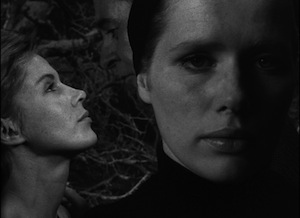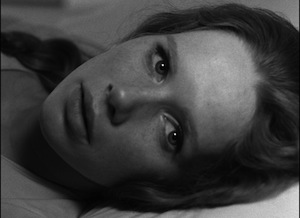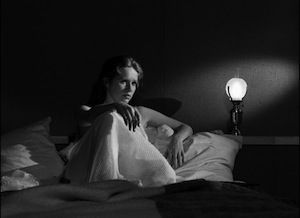 Perhaps more than any other art-house European film of the 1960s, Ingmar Bergman‘s striking 1966 masterpiece Persona embodies the period. It is at once impenetrable and deeply emotional. It is a challenge to the medium of film and traditional storytelling. It’s also a deeply personal work.
Perhaps more than any other art-house European film of the 1960s, Ingmar Bergman‘s striking 1966 masterpiece Persona embodies the period. It is at once impenetrable and deeply emotional. It is a challenge to the medium of film and traditional storytelling. It’s also a deeply personal work.
In other words, Persona isn’t some puzzle that you need to figure out. Rather, it’s a movie that should be experienced and interpreted on an individual level.
With the fantastic new dual-format Blu-ray-DVD release from The Criterion Collection, you’ll get all the context and background information you need to understand where Bergman was coming from when he made the film, but the way it plays for you will likely be an experience very specific to you.
The movie has one of the most famous opening sequences in film history — a six-minute series of seemingly unrelated shots that set the tone right away. Droning, rising strings on the soundtrack immediately jar you and remind you that you’re watching a film. What you are about to see is a construction. A ribbon of film flutters around a projector.
 The film counts down: 11, 10, 9 , 8, 7, instead of a 6, there’s three frames of an erect penis. Yes, this will be sexual. There’s a nail being driven into a hand. Yes, it will be uncomfortable. Characters stare into the abyss. Directly at you. Yes, it is self-aware.
The film counts down: 11, 10, 9 , 8, 7, instead of a 6, there’s three frames of an erect penis. Yes, this will be sexual. There’s a nail being driven into a hand. Yes, it will be uncomfortable. Characters stare into the abyss. Directly at you. Yes, it is self-aware.
The prologue features close-ups of faces that will figure prominently in the film, symbolically foreshadowing the themes that will be explored later. What makes Persona so provocative, however, is that all this meta stuff — this breaking of the fourth wall and blatant artifice — is in the service of introspection, not over-intellectualization.
 Bergman was depressed and confined to a hospital bed during the two weeks that he wrote Persona. It was always meant to be self-aware; its original title was Cinematography. And because it deals with close, intra-personal relationships, the artifice being examined are the things we hold closest to the chest: the masks we wear, the isolation we sometimes feel, the manipulations we construct.
Bergman was depressed and confined to a hospital bed during the two weeks that he wrote Persona. It was always meant to be self-aware; its original title was Cinematography. And because it deals with close, intra-personal relationships, the artifice being examined are the things we hold closest to the chest: the masks we wear, the isolation we sometimes feel, the manipulations we construct.
Liv Ullmann plays Elisabet Vogler, a theater actress who has stopped speaking. She’s hiding all kinds of anxieties, and has retreated completely. Bibi Andersson is Alma, the young nurse tasked with taking care of her — first in the hospital and later at a relaxing beach house. Alma opens up to Elisabet, who finds great comfort in her new role of confessore. Or does she? And why has she stopped speaking if the doctors can’t find anything physically or mentally wrong with her?
 In one of the many interview segments added to this excellent Blu-ray-DVD package (all features are duplicated across both formats), Bibi Andersson says that for she and Ullmann, the film represents two sides of the same person who is in conflict with themselves. At least this is how they made sense of it while filming.
In one of the many interview segments added to this excellent Blu-ray-DVD package (all features are duplicated across both formats), Bibi Andersson says that for she and Ullmann, the film represents two sides of the same person who is in conflict with themselves. At least this is how they made sense of it while filming.
In the same vintage interview, Bergman avoids giving the interviewer an easy interpretation, saying that they had a working theory while making the film, but that it would be “utterly stupid to superimpose that upon other people’s perceptions.”
The close-ups. Oh, the close-ups. Liv Ullmann staring straight into camera as the light slowly goes down. It’s very similar to they way a kid was staring at us before. Then he tried to touch a larger-than-life, constantly morphing image of a woman’s face. Are they also talking directly to us? Persona plays out in sections, each with a distinct feel.
 When Alma and Elisabet retreat to the beach house, the sound of the film shifts abruptly. Gone are the long stretches of silence. It goes from little to no dialogue to a constant, bubbling (or babbling) stream of dialogue from Alma. What’s weirder, a nameless narrator comes out of nowhere 20 minutes into the film to reset the stage.
When Alma and Elisabet retreat to the beach house, the sound of the film shifts abruptly. Gone are the long stretches of silence. It goes from little to no dialogue to a constant, bubbling (or babbling) stream of dialogue from Alma. What’s weirder, a nameless narrator comes out of nowhere 20 minutes into the film to reset the stage.
Serenity makes way for betrayal.
The film melts, then breaks. A chapter break. Break under the pressure of everything before it. Jarring music, the nail through hand, a slapstick old-timey devil. a black comedy. Someone clearly has the upper hand.
 Persona becomes a psychodrama with two sides battling for control. It escalates. A genuine fear of one person being scarred for life during an intense fight. Throughout it, Liv Ullmann’s only word: “Nothing.”
Persona becomes a psychodrama with two sides battling for control. It escalates. A genuine fear of one person being scarred for life during an intense fight. Throughout it, Liv Ullmann’s only word: “Nothing.”
Another groundbreaking formal element: A long monologue by Alma is heard while DP Sven Nykvist‘s camera stays on Ullman, listening in one unbroken take. The story is repeated again, this time with Alma’s face being the only one shown.
Persona probes the depths of the human psyche, even as it examines the ways in which people tell stories and create new realities. Its themes are timeless, and it still holds up today.
The extra supplements include Liv & Ingmar, a 2012 feature documentary directed by Dheeraj Akolkar and more:
- New visual essay on the film’s prologue by Ingmar Bergman scholar Peter Cowie
- New interviews with actor Liv Ullmann and filmmaker Paul Schrader
- Excerpted archival interviews with Bergman, Ullmann, and actor Bibi Andersson
- On-set footage, with audio commentary by Bergman historian Birgitta Steene








{ 1 comment }
Just picking nits here: Elisabet has a 10 word sentence, and later adds another 4 words to the collection. We also disagree on about everything else except for the cinematography. Bergman had affairs with both women and had a totally screwed up perception of what his role was in the whole mess. That opening montage was just a pretentious diversion invented on the spot, in the editing room, to give reviewers something to talk about.
Comments on this entry are closed.